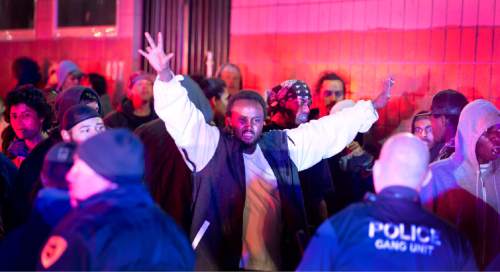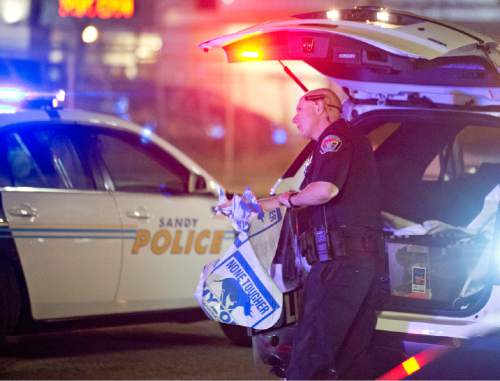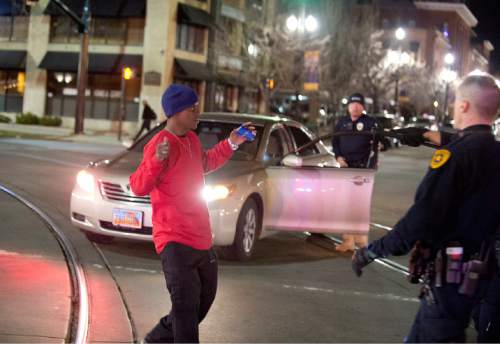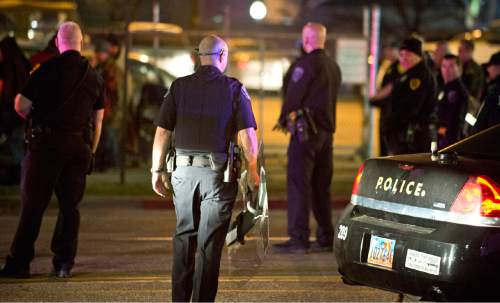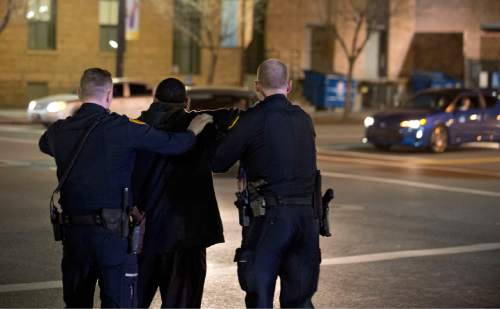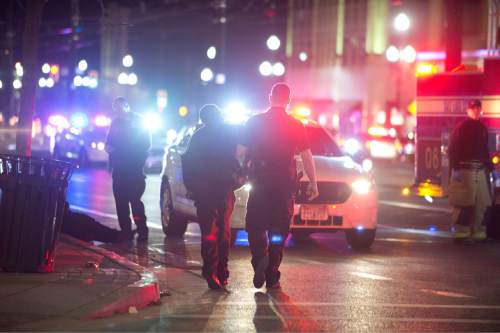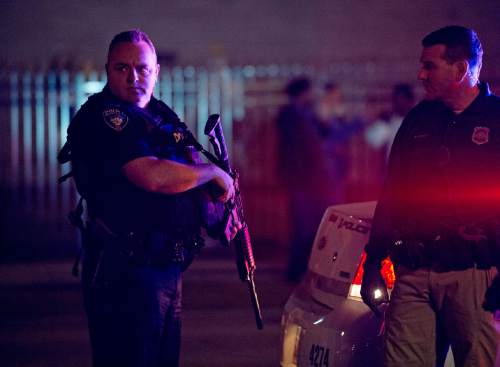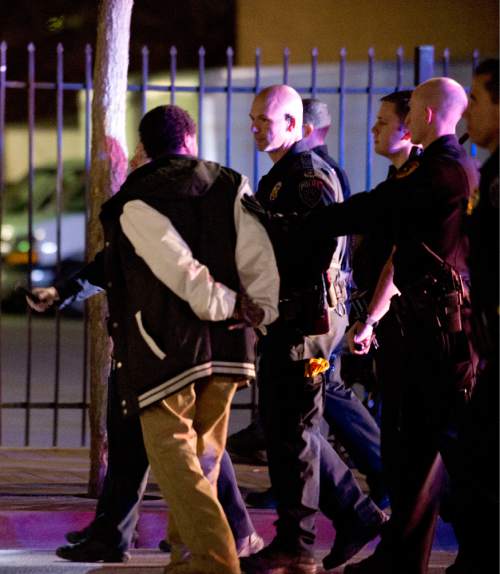This is an archived article that was published on sltrib.com in 2016, and information in the article may be outdated. It is provided only for personal research purposes and may not be reprinted.
Members of the crowd hurled softball-size rocks and glass bottles as police radioed for support on all sides of Salt Lake City's homeless shelter — in an instant, the center of a national debate about the use of force against young black men.
Roughly 100 officers would arrive after the shooting of 17-year-old Abdullahi Omar Mohamed on Feb. 27, a Saturday night. While accounts of their response are fairly consistent, opinions vary on its appropriateness.
To interim Salt Lake City Police Chief Mike Brown, it was "a pretty good play," officers stabilizing an emotional scene with a handful of logistical challenges, an increasingly common occurrence nationwide.
Others say the police activity was excessive and added to a feeling that law enforcement struggles to view members of minority and economically challenged communities as anything other than threats.
Former Salt Lake City Councilwoman Deeda Seed was troubled by Salt Lake Tribune photos that show officers holding riot shields and a U. police officer pulling an assault rifle from the trunk of his car.
It recalled for her a 1999 raid that nearly triggered a riot at a peaceful Sunday drum circle in Salt Lake City's Liberty Park. She hopes it will inform future police responses.
"I've never had a gun pointed at me, thank God," Seed said, "but pictures of police officers from various agencies pointing their weapons at unarmed people — frankly, that's terrifying."
After meeting with Brown last Sunday, she said, "his explanation kind of makes sense."
Brown told The Tribune that his department's intent was not to intimidate the crowd in an "overwhelming show of force." Rather, Brown said, officers radioed "9-1, 10-33," city and county codes for "officer needs assistance" that Salt Lake City police Detective Greg Wilking said are used maybe once per year. Such a call attracts every available law enforcement officer in the area.
"The idea is you get people there, get them en route," Brown explained, "and if the situation stabilizes, you can cancel people."
—
It started with gunshots • Police shot Mohamed at 8:03 p.m. after they say he and another man used "metal objects" to attack an unarmed victim near the shelter at 210 S. Rio Grande. While the other man dropped his weapon and fled, police say, Mohamed continued to advance on the victim. He was shot three times.
Mohamed's friend, Selam Mohammad, has challenged that account. She said Mohamed was defending her — he and the other assailant dueling with ends of a broken broomstick. Mohamed had his back to the two officers when they told him to drop the stick, she said, and one officer fired after Mohammad called to him and he began to turn toward her.
Salt Lake County District Attorney Sim Gill declined Thursday to release video from the officers' body cameras until his office determines if the shooting was justified.
It "may take weeks or even months to conclude" the investigation, he said in a news release.
Mohammad described the immediate aftermath as "like martial law."
As police ordered an evacuation of Rio Grande, the street east of the shelter that bisects the blocks between 400 South and 200 South and between 400 West and 500 West, Mohammad said they kicked people's stuff and waved at them with batons.
"The people are like, 'This is our home. We don't have a home. Why are you kicking us out?' "
Mohammad said one man cried unattended after being stunned by a Taser.
Gabriella Killpack, a member of Utah Against Police Brutality, lives near the shelter. She heard the shots and arrived at the scene about five minutes later.
Though at least four men would be booked on suspicion of riot-related charges — one of them stunned, according to his booking statement — Killpack said the people at the scene were not rioting.
"A few people were throwing things," she said. "That's it. It was totally out of proportion with the amount of police."
Utah Against Police Brutality member Gregory Lucero termed it a "police riot" after a community meeting about the shooting at a city library Wednesday night.
—
'Ferguson effect' • Retired Weber State University criminal-justice professor Robert Wadman — who served as a police chief in four cities — said police in such situations often will resort to "a show of force strong enough that anybody looking at it knows that they're not going to have that much success."
Wadman said shows of force often are successful, but that a "Ferguson effect" heightens the importance of appearances in the wake of the headline-grabbing unrest that broke out after a police shooting near St. Louis.
Some members of the crowd were in tears, Killpack said, and some yelled at police or joined in chants. Killpack said she observed "a distinct contrast" between the emotion of traumatized bystanders and the nonchalance of officers, who she said smiled and laughed in conversations with one another.
Utah Highway Patrol Capt. Jess Anderson said it was a tense time for officers and bystanders alike, and if officers were observed laughing, it might have been that they were trying to let off steam.
Police already had a large presence in the area that night. Saturday nights are staffed heavily anyway, and Salt Lake City police and Utah Highway Patrol had additional units involved in a DUI saturation effort. Officers also were assigned to control traffic as the Utah Jazz played the Brooklyn Nets about two blocks northeast.
Brown said only a fraction of the 100 officers — responding agencies also included police from West Valley City, Sandy and Unified Police — were there at a given time.
Officers addressed logistical concerns, too. Among them: the proximity of the south end of the outdoor Gateway mall — where comedian Margaret Cho performed that night at the Wiseguys comedy club — two stops on the city's TRAX light-rail line and the ongoing Jazz game.
Police mobilized in large numbers around the shelter, one seen peeling the protective cover off a new riot shield.
First, they cleared the shooting scene on Rio Grande. Brown said it's "critical" to stabilize such scenes quickly so that medical and fire units can deliver aid. Their protocols do not allow them to enter unsafe scenes, where they have no means of defending themselves.
Mohammad said that was what police told her, too, but that after a crowd estimated at anywhere between 50 and 200 people was moved off the street, it was another 15 to 20 minutes before the ambulance arrived.
A representative from Gold Cross Ambulance Services said emergency personnel made contact with Mohamed at 8:17, about 13 minutes after he was shot, but that two ambulances were staging nearby until the area was deemed safe.
About 30 minutes after the shooting, a line of officers moved people off the south side of 200 South from Rio Grande to 400 West.
Mohammad said that as she crossed the street to talk to a camera crew from a news station, she was told to put her hands up, grabbed and taken to the sidewalk.
"They're like, 'You're not talking to nobody,'" she said.
—
Community policing • At least five people were arrested for their actions, and another witness was booked on an outstanding warrant.
Booking statements indicate one man turned to hit an officer, who took him to the ground. Others threw objects, including a flashlight.
Brown predecessor Chris Burbank, who was forced out last June after then-Mayor Ralph Becker accused him of mishandling sexual-harassment complaints brought against a deputy chief, said that when the focus of the frustration is police, a heavy-handed officer response can increase that frustration.
"You don't want lawless out-of-control burning and looting," Burbank said. "You cannot tolerate that. But also the approach that you line up everybody in riot gear and shields and start moving them away — where are you moving them to? The homeless shelter is where they need to be."
To flood a scene with heavy weapons, riot shields and police, Seed said, gives the impression that law enforcement no longer sees the importance of community policing. "Some of us feel like, 'Oh, they really enjoy this. They're descending and putting all this military gear on and getting very happy being authoritarian figures.' "
Wadman, the retired Weber State professor, said police have opted for an anti-terrorism approach since the events of Sept. 11, 2001, emphasizing more sophisticated equipment and militaristic tactics.
Events such as those in Ferguson are starting to remind them, he said, that "if a police officer knows everybody that they're around, I'm much safer as a police officer than if I don't know anybody."
Becker and Brown called for increased patrols of Rio Grande in July, opposed by Burbank on the grounds that "we can't arrest our way out of this."
Seed said she's "cautiously optimistic" that Salt Lake City police will recommit to community policing under newly elected Mayor Jackie Biskupski.
Brown, for his part, has said he's not interested in so-called broken-window policing and touted his department's plan to hire eight social workers and target high-level drug dealers, not users, on Rio Grande.
But Brown said he has few regrets about the personnel committed to the scene Saturday. The Salt Lake Police Association said in a statement that the coordinated response "allowed the situation to be brought under control in a very short period of time and without any further injuries to either the public or law enforcement."
That lack of injury, said Brown, makes him regard the operation as a success.
— The Tribune's Michael McFall and Lennie Mahler contributed to this story.
mpiper@sltrib.com Twitter: @matthew_piper —
Inside
A closer look at Abdullahi Mohamed. › B5 —
A first test for Utah's reactivated crowd control force
Joining the efforts to control the scene Saturday night was a specialized unit of the Utah Department of Public Safety, created in 2013 at the request of newly appointed Commissioner Keith Squires.
Squires said he was concerned that his officers weren't trained to control unruly crowds and that "sometimes there could have been the potential for overreaction" if untrained officers arrived at such a scene.
His solution: a "public protection unit," similar to the units that responded to unrest during the 2002 Winter Olympics at the Budweiser entertainment center in Gallivan Center but were later disbanded.
Thirty of his officers received instruction from the Department of Homeland Security in Alabama and have since trained quarterly to better understand crowd control tactics and First Amendment protections, Squires said.
Those officers have riot gear in their vehicles at all times.
Saturday night's officer-involved shooting of 17-year-old Abdullahi Omar Mohamed gave 20 members of the unit their first live experience, working to clear the scene and hold it so valley police agencies could address calls elsewhere.
Capt. Jess Anderson, who heads the unit, said he was "very pleased" with his team's performance.
Anderson said his officers "kept a calm and cool head" amid yelling, heckling and the throwing of dangerous projectiles.
"It's the few that want to be rowdy or get things stirred up, and that's kind of what we experienced Saturday night," he said.
Squires said one state trooper was hit in the shoulder with a rock but wasn't seriously injured.


